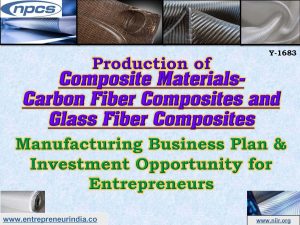Manufacturing of Composite Materials

Production of Composite Materials-Carbon Fiber Composites and Glass Fiber Composites. Manufacturing Business Plan & Investment Opportunity for Entrepreneurs.
Composite materials have played an important role throughout human history, from housing early civilizations to enabling future innovations. Composites offer many benefits; the key among them are corrosion resistance, design flexibility, durability, light weight, and strength. Composites have permeated our everyday lives such as products that are used in constructions, medical applications, oil and gas, transportation, sports, aerospace, and many more. Some applications, such as rocket ships, probably would not get off the ground without composite materials. the advantages of Fibre composite materials as well as fundamental effects, product development, and applications of Fibre composites, including material chemistry, designing, manufacturing, properties, and utilization of the materials in various applications.
Related Project: – Composite Materials-Carbon Fibre Composites & Glass Fibre Composites
Characteristics of Composite Materials
High specific strength and modulus, as well as high fatigue strength and fatigue damage tolerance
Anisotropic
Designable or tailor able materials for both microstructure and properties
Production of both material and structure or component in a single
Operation – manufacturing flexible, net-shape, complex geometry Corrosion resistance and durable
Other unique functional properties – damping, low CTE (coefficient of thermal expansion)
Related Projects: – New Projects
Why use Composites?
Weight saving is one of the main reasons for using composite materials rather than conventional materials for components. While composites are lighter they can also be stronger than other materials, for example, reinforced carbon-Fibre can be up to five times stronger than 1020 grade steel and only one fifth of the weight, making it perfect for structural purposes.
Another advantage of using a composite over a conventional type of material is the thermal and chemical resistance as well as the electrical insulation properties. Unlike conventional materials, composites can have multiple properties not often found in a single material.
Fibre reinforced composites, such as Fibre reinforced plastic (FRP composites), are finding increasing use in the design and manufacture of final products for commercialization.
Related Projects:- Carbon Fiber, Carbon Fiber Composites, Graphite Fibre and Carbon Fiber Reinforced Polymer Projects
Uses
As with all engineering materials, composites have particular strengths and weaknesses, which should be considered at the specifying stage. Composites are by no means the right material for every job.
However, a major driving force behind the development of composites has been that the combination of the reinforcement and the matrix can be changed to meet the required final properties of a component. For example, if the final component needs to be fire-resistant, a fire-retardant matrix can be used in the development stage so that it has this property.
Weight Reduction
Durability and Maintenance
Added Functionality
Design Freedom
Related Videos:- Carbon Fiber, Carbon Fiber Composites, Graphite Fibre and Carbon Fiber Reinforced Polymer Projects
Market Outlook
The global composites market size is projected to grow from USD 74.0 billion in 2020 to USD 112.8 billion by 2025, at a CAGR of 8.8%. The composites industry is growing due to the rise in demand for high performance materials, globally. The automotive segment is becoming increasingly obsessive with consumption of carbon fiber and has increased significantly over the past years. The increasing demand for electric vehicles in countries like China and United States is also a major driving factor for the demand for composite material.
Asia Pacific had the largest composite material demand and is anticipated to continue dominance owing to favorable FDI policies by Indian and Chinese Governments over the next seven years. Developed regions including North America and Europe are expected to follow Asia Pacific over the next seven years on account of rising lightweight materials used for vehicle components. Nonetheless, lower per capita composite materials consumption in BRIC is expected to provide an impetus for market growth over the forecast period. Favorable government regulations are anticipated to lower entry barriers for new market participants in emerging economies resulting in higher market fragmentation over the next seven years. Increasing demand for lightweight materials in the aerospace and defense industry is expected to drive the demand.
Related Project:- Composite Materials-Carbon Fibre Composites & Glass Fibre Composites
Composite materials are more expensive than other plastic materials that are utilized in the manufacture of vehicles. This is expected to restrain the automotive composite materials market to some extent in the near future. The basic cost of carbon fiber is way higher than that of metal. Furthermore, the processing of carbon fibers is an expensive process, especially when it comes to mass production of automotive components. However, the development of low-cost manufacturing methods for automotive composites is receiving a lot of attention from leading vehicle manufacturers across the world. These drawbacks of composite materials are expected to hamper the automotive composite materials market.
Projects: – Project Reports & Profiles
Key players:-
Ahlstrom Munksjo Fiber composites India Pvt. Ltd.
Chevron Glassfibre Reinforcements Ltd.
Cosmos Fibre Glass Ltd.
Everlast Composites Pvt. Ltd.
Goa Glass Fibre Ltd.
Hindoostan Technical Fabrics Ltd.
Ineos Styrolution India Ltd.
Jushi India Pvt. Ltd.
Magnus Composites Synergies Pvt. Ltd.
Owens Corning Inds. (India) Pvt. Ltd.
Teijin India Pvt. Ltd.
U P Twiga Fiberglass Ltd.